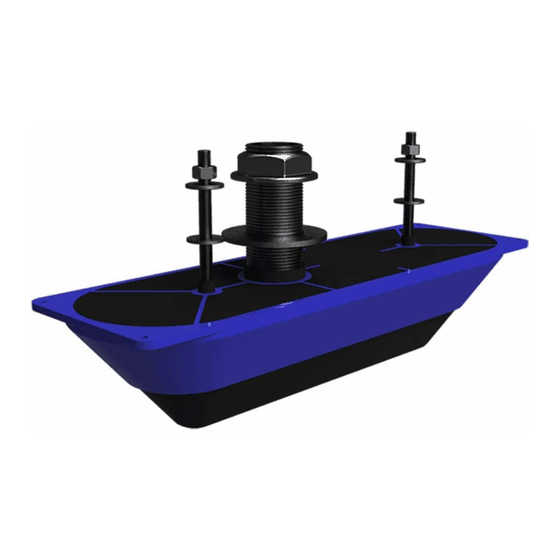
Table of Contents
Advertisement
Quick Links
OWNER'S GUIDE
Thru-Hull
Anti-rotation Hardware
with
StructureScan
Models: SS70, SS70-TS
Follow the precautions below for optimal
product performance and to reduce the risk of
property damage, personal injury, and/or death.
WARNING: Installation of the anti-rotation studs/screws
is mandatory! The anti-rotation studs/screws hold the fairing
firmly in place. Failure to install the anti-rotation studs/screws
may result in the fairing rotating while the boat is underway.
The effect may be violent movement and loss of steering.
WARNING: The transducer must be installed parallel to
the keel/centerline to ensure proper boat handling and
water flow under the transducer.
WARNING: Always wear safety glasses, a dust mask,
and ear protection when installing.
WARNING: Immediately check for leaks when the boat is
placed in the water. Do not leave the boat in the water
unchecked for more than three hours. Even a small leak
may allow a considerable amount of water to accumulate.
WARNING: SS70, SS70-TS, SS141L with Fairing—
The fairing must be screwed to a block of wood before
cutting. It is too thin to cut safely without additional
material. Failure to do so may result in the fairing moving
on the band saw.
WARNING: Fairing—Do not install a fairing that has
been mis-cut. Replace it.
• Cutting the fairing at an angle greater than the
maximum allowed will cut into the transducer and/or
anti-rotation pockets, thus weakening the fairing.
• Do not allow any gap between the fairing and the hull
that is greater than 1.5mm (1/16"). When the boat is
underway, water will enter any gaps and push against
the fairing with considerable force, possibly rotating it.
WARNING: Fiberglass hull—The transducer must be
installed in solid fiberglass, not in coring.
CAUTION: Never install a metal transducer on a vessel
with a positive ground system.
CAUTION: Never pull, carry, or hold the transducer by
the cable as this may sever internal connections.
CAUTION: Never strike the transducer.
Transducer
™
SS141L
&
INSTALLATION INSTRUCTIONS
Record the information found on the cable tag for future reference.
Part No:____________________Serial No:________________________
Date_______________Frequency____________________________kHz
CAUTION: Stainless steel transducer in a metal hull—
Stainless steel must be isolated from a metal hull to
prevent electrolytic corrosion. Use the isolation sleeving
supplied.
CAUTION: Transducer Pair—Be sure to connect the
port transducer and the starboard transducer to the
correct terminals on the StructureScan module. If the
transducers are connected in reverse, the display will not
work properly.
CAUTION: Never use solvents. Cleaner, fuel, sealant,
paint, and other products may contain solvents that can
damage plastic parts, especially the transducer's face.
IMPORTANT: Read the instructions completely before
proceeding with the installation. These instructions
supersede any other instructions in your instrument
manual if they differ.
Applications
• Stainless steel is compatible with all hull materials. Recommended
for aluminum hulls to prevent electrolytic corrosion, provided the
stainless steel transducer is isolated from the metal hull.
• Recommended for boats capable of speeds up to 30kn
(35MPH). Optimal speed is 1.5 - 8.5 kn (2 - 10MPH).
• SS70, SS70-TS, SS141L—A fairing is strongly recommended if
the deadrise angle of the hull exceeds 10. The fairing can
accommodate a deadrise angle of up to 22°.
• SS70, SS141L—On a boat with a steep deadrise angle, a pair of
transducers, one on the port side and one on the starboard side,
can be installed and connected to the StructureScan module.
Identify Your Model
The model name is printed on the cable tag.
BOW
fairing
SS141L
►
Advertisement
Table of Contents

Summary of Contents for Airmar StructureScan SS70-TS
- Page 1 OWNER’S GUIDE & INSTALLATION INSTRUCTIONS Thru-Hull Record the information found on the cable tag for future reference. Anti-rotation Hardware with StructureScan Transducer Part No:____________________Serial No:________________________ ™ Date_______________Frequency____________________________kHz Models: SS70, SS70-TS ► SS141L fairing SS141L CAUTION: Stainless steel transducer in a metal hull— Follow the precautions below for optimal Stainless steel must be isolated from a metal hull to product performance and to reduce the risk of...
-
Page 2: Tools And Materials
150-300mm (Load Waterline Length) (6-12") steep deadrise hull with two transducers Figure 1. SS70, SS70-TS, SS141L: Best location Copyright © 2010 - 2017 Airmar Technology Corp. - Page 3 Deadrise angle and fairing thickness Figure 3. Cutting the fairing (SS141L shown) Copyright © 2010 - 2017 Airmar Technology Corp. Copyright © 2010 - 2016 Airmar Technology Corp. Installation: SS70, SS70-TS, SS141L 10.Use the remaining section of the fairing with the cutting guide as the backing block.
- Page 4 Figure 4. SS70, SS70-TS, SS141L: Bedding and installing with a fairing in a fiberglass or wood hull (SS141L shown) Copyright © 2012 - 2017 Airmar Technology Corp. each one in turn. Do not use pliers farther up, as this will damage Bedding the threads.
- Page 5 (2) Figure 6. SS70, SS70-TS, SS141L: Bedding and installing WITHOUT a fairing in a fiberglass or wood hull (SS141L shown) Copyright © 2013 - 2017 Airmar Technology Corp. • NO fairing—Slide the rubbery washer and hull nut onto the Installing cable.
-
Page 6: Cable Routing & Connecting
Cable Routing & Connecting StructureScan CAUTION: Do not remove the connector(s) to ease cable routing. If a cable must be cut and spliced, use Airmar’s splash-proof Junction Box No. 33-035 and follow the instructions provided. Removing the transducer 2 transducer 1... -
Page 7: Installation In A Cored Fiberglass Hull
Figure 12. Preparing a cored fiberglass hull outside the hull through the outer skin only. Be sure to hold the Copyright © 2005 Airmar Technology Corp. drill plumb, so the hole will be perpendicular to the water surface. 3. The optimal interior hole diameter is affected by the hull’s Maintenance, Parts &... - Page 8 35 Meadowbrook Drive, Milford, New Hampshire 03055-4613, USA • www.airmar.com Copyright © 2012 - 2022 Airmar Technology Corp. All rights reserved.
















Need help?
Do you have a question about the StructureScan SS70-TS and is the answer not in the manual?
Questions and answers